
CALRAD
45 series -
AC-DC adapter informationRegulated Versus Un-regulated DC power supplies
Regulated power supplies provide a cleaner
power source and provide more protection to the devices itís connected to.
Regulated power supplies are not always the best or most economical way to go,
some devices or products have their own regulators and protection circuits
built-in, in this case a regulated power supply would not be necessary and the
unregulated power supply would be the best choice. Always check with the
manufacturer of a product or look at the adapter that your replacing and make
the correct selection. Most specifications are listed on the adapter.
Regulated power supplies will maintain a near constant
voltage over the load range of the power supply and will provide a cleaner DC
output with less AC ripple. Regulated power supplies also offer short circuit
and current foldback protections. You can always use a regulated power supply in
place of a non-regulated power supply as long as the voltage and current
specifications match.
Important AC adapter information
